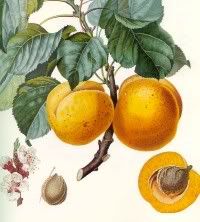

Apricot (Prunus armeniaca vulgaris)
Folk Names: Apricock
Description: For a long time, it was thought the Apricot originated in Armenia, hence its name Armeniaca, but it is now generally accepted that its origins lie in China, particularly the Himalayan region. It was introduced into England from Italy during Henry VIII reign. The tree, which is most closely related to peaches and plums, prefers temperate climates but dislikes frost. Sometimes espaliered against walls in northern climates to protect it from the elements, it will rarely fruit in such areas otherwise. It should be planted on the northern side of a slope or building to escape the sun's warmth in early spring, but it needs sun and well-drained soil for good fruit production. The apricot rarely stands more than twenty to twenty-six feet. It has a stout trunk with reddish-brown bark. The simple, leathery, alternating leaves are deciduous, ovate or rounded, sharply pointed at tip and double toothed. The flowers appear before the leaves, solitary or in pairs. They have white or pinkish obovate petals. The fruit is a velvety globose, oblong drupe, slightly flattened and divided by a central groove. It is orange-yellow, often tinged with red and ripens from the end of July to mid-August
Effects: gentle
Planet: Venus
Element: water
Associated Deities: Venus
Traditions:
none noted
Magic:
Apricots may be eaten to obtain a sweet disposition. The juice is used in love potions and spells, and the leaves and flowers are added to love sachets. The pit may also be carried to attract love.
Known Combinations:
none noted
Medical Indications: Parts Used: fruit, seed
The fruit is a good source of vitamins A and niacin, potassium, and iron. Fresh or dried and mashed, the fruit may be mixed with warm olive oil for a dry skin paste. The oil may also be used to treat dry skin. Add it to any mixtures or masks for this purpose.
Nutrition:
The fruit, and in some varieties the seed, is edible. The constituents of the apricot is similar to that of bitter almond and the oil may be used interchangeably with almond oil.
Mercantile Uses:
The oil produced by the seed is used in perfume and soap. It is imported in large quantities from Syria and California. The oil is also used by confectioners in place of almond oil. Eau de Noyaux is a French liqueur produced from the apricot kernel. The oil is far less expensive than almond oil and is virtually indistinguishable. In fact, it is often fraudulently added to almond oil without the buyer's knowledge.